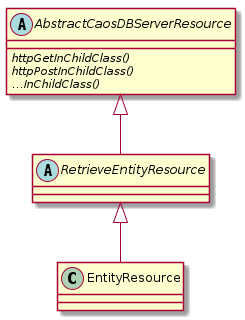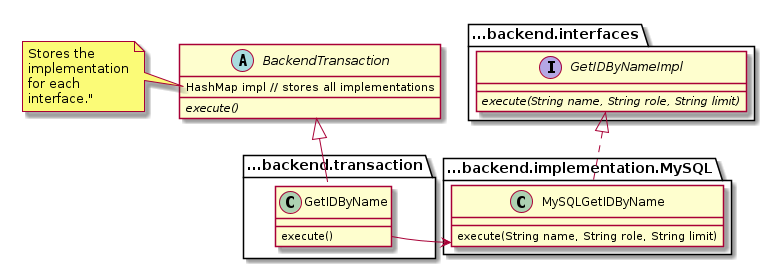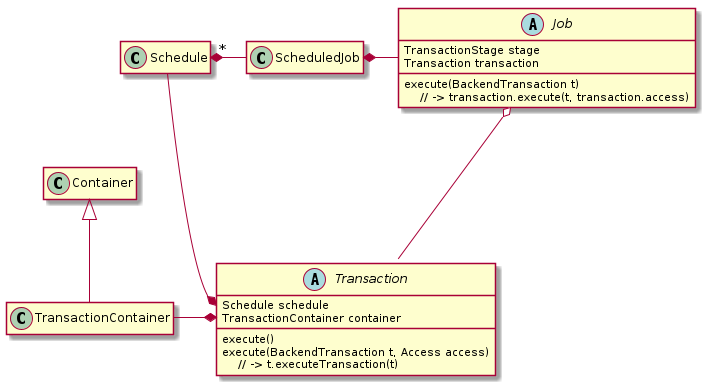CaosDB’s Internal Structure
The CaosDB server
builds upon the Restlet framework to provide a REST interface to the network. See the HTTP Resources section for more information.
uses an SQL database (MariaDB or MySQL) as the backend for data storage. This is documented in the MySQL Backend section.
has an internal scheduling framework to organize the required backend jobs. Read more on this in the Transactions and Schedules section.
may use a number of authentication providers. Documentation for this is still to come.
HTTP Resources
HTTP resources are implemented in the resource package, in
classes inheriting from AbstractCaosDBServerResource (which inherits Restlet’s
Resource class). The main CaosDBServer class
defines which HTTP resource (for example /Entity/{specifier}) will be handled by which class
(EntityResource in this case).
Implementing classes need to overwrite for example the httpGetInChildClass() method (or methods
corresponding to other HTTP request methods such as POST, PUT, …). Typically, they might call the
execute() method of a Transaction object.
Transactions are explained in detail in the Transactions and Schedules section.

MySQL Backend
The MySQL backend in CaosDB may be substituted by other backends, but at the time of writing this documentation, only MySQL (MariaDB is used for testing) is implemented. There are the following main packages which handle the backend:
backend.interfacesInterfaces which backends may implement. The main method for most interfaces is
execute(...)with arguments depending on the specific interface, and benchmarking methods (getBenchmark()andsetTransactionBenchmark(b)may also be required.backend.implementation.MySQLMySQL implementations of the interfaces. Typical “simple” implementations create a prepared SQL statement from the arguments to
execute(...)and send it to the SQL server. They may also have methods for undoing and cleanup, using anUndoHandler.backend.transactionclassesSubclasses of the abstract
BackendTransactionwhich implement theexecute()method. These classes may use specific backend implementations (like for example the MySQL implementations) to interact with the backend database.
For example, the structure when getting an Entity ID by name looks like this:

Transactions and Schedules
In CaosDB, several client requests may be handled concurrently. This poses no problem as long as only read-only requests are processed, but writing transactions need to block other requests. Therefore all transactions (between their first and last access) block write transactions other than themselves from writing to the backend, while read transactions may happen at any time, except when a write transaction actually writes to the backend.
Note
There is a fine distinction between write transactions on the CaosDB server and actually writing to the backend, since even transactions which need only very short write access to the backend may require extensive read access before, for example to check for permissions or to check if the intended write action makes sense (linked entities must exist, they may need to be of the correct RecordType, etc.).
The request handling in CaosDB is organized in the following way:
HTTP resources usually create a
Transactionobject and call itsTransaction.execute()method. Entities are passed to and from the transaction viaTransactionContainers(basically normalContainers, enriched with some metadata).The Transaction keeps a
Scheduleof relatedJobs(each also wrapping a specific Transaction), which may be called at different stages, calledTransactionStages.The Transaction’s
execute()method, when called, in turn calls a number of methods for initialization, checks, preparations, cleanup etc. Additionally the scheduled jobs are executed at their specified stages, for example all jobs scheduled forINITare executed immediately after callingTransaction.init(). Please consult the API documentation forTransaction.execute()for details.Most importantly, the (abstract) method
transaction()is called byexecute(), which in inheriting classes typically interacts with the backend viaexecute(BackendTransaction, Access), which in turn calls theBackendTransaction’sBackendTransaction.executeTransaction()method (just a thin wrapper around itsexecute()method).
Summarized, the classes are connected like this:
